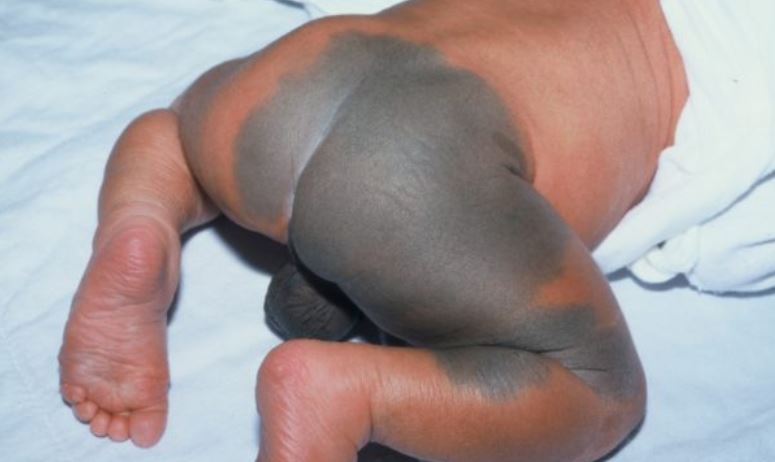What is a Mongolian birthmark? Why do some babies this birthmark characterized by gray-blue pigmentation on their backs, buttocks, face or legs? What is the meaning of the adult onset, unilateral, progressive, gray-blue pigmentation on their back? Are these pigmentation related to any medical condition?
Now to attain satisfying answer to these questions, we are going to examine what it is, causes, signs, and symptoms, who is vulnerable to this type of birthmark, which part of the body can these pigments be found.
How they look like – pictures
Table of content
To get a hint on how they look like and the vaarious places you can have them, here are a few pictures:



Meaning
Mongolian birthmark, spot, or congenital dermal melanocytosis are flat, blue or gray-blue markings that usually found on the lower back, bottoms or on the face of infants at birth or soon afterward. They can occasionally be noticed on the legs or shoulders of the newborn.
It sometimes looks similar to bruises, which make them possibly connected to child abuse in some circumstances.
Mongolian birthmarks usually occur as multiple spots or large patches. They have wavy borders and irregular shape.
In most cases, this pigmentations or lesions usually disappear within 1-4 years of birth but widespread, extrasacral and dark colored Mongolian spot sometimes persist into adulthood.
The birthmark was first described and named after Mongolians by a German anthropologist, Erwin Balz who was based in Japan in 1883.
It is very important to understand that both female and male newborns are equally vulnerable to it.
Causes of Mongolian spots
This kind of birthmark is caused by a collection of pigment-producing cells (melanocytes) that are found in a deeper layer in the skin. So the bluish (gray-blue, dark blue) color develops when the dermal melanocyte fails to move to the top layer of the skin and persist there instead of disappearing.
Usually, these cells should disappear by the 20th week of pregnancy. Doctors have not yet found the reason behind the failure of these cells to disappear, but this condition is not linked to anything that a mother do or don’t do during pregnancy.
Some cases have been reported in medical journals where infants with widespread cases also experience some metabolic disorders. This is a very rare observation.
Signs and diagnosis
The reasonably characteristic in the appearance of Mongolian spots renders them no need to have special test or diagnosis. However, sometimes due to their color and location, they can be erroneously be confused with bruises.
The difference between the two is that bruises usually change their color and shape over short periods while on the other side, it takes several years to diminish.
Secondly, the spots are not painful to the touch and do not need any exceptional care, unlike bruises.
Here are the summarized characteristics of Mongolian blue spots:
- There are usually blue or blue-gray spots on the back, bottoms, base of spine, shoulders, legs or face
- The normally take the texture of the skin
- They are flat with irregular shape and wavy borders
- The usually range between 2 to 10 centimeter in diameter
- They don’t cause any pain
- Take many years to fade
Who can get it?
They are very widespread in children of African, Middle Eastern, Mediterranean or Asian background. Some researchers have revealed that almost three-quarter of infants from these backgrounds is born with Mongolian birthmark.
Due to this large numbers of Mongolian infants, there have been questions if this condition is inherited but there is no clear clue yet.
On the other hand, they are rare in children with a white European background.
Again, as we have said before, these spots can occur in both boys and girls. However, they are somewhat more common in boys than in girls. The cause of this observation is not yet known.
Regardless of the name, they have no known anthropologic implication, except for being more conventional in darker-skinned infants.
In adults
These are types that persist right from birth to adulthood. The reason why Mongolian spots may persist into adulthood is not clearly known. If it happens in adults, the condition may make some people become very shy or self-conscious especially when the spots are located in the face or somewhere where it is visible. In fact, up to around the year 1993, this was an issue of concern to Asian men.
Removal and Treatment
Can they be removed? Can these spots be treated? This section is going to discuss means through which you can get rid of those Mongolian spots or birthmarks.
Dermal melanocytosis is benign, which do not need any therapy or treatment. This harmless condition will resolve on its own. Usually, they impulsively disappear by the time a child will reach 4 years old and they do not pose don’t pose any potential health risk, However, there are rare cases where you will find large and numerous spots that persist after a four year. This may be connected with rare genetic disorders.
As you wait for it to disappear, you can use cosmetic camouflage to cover them. For those who do not like these spots, laser birthmark removal may be employed to remove the pigments as we are going to see. It should be noted that use of some laser mechanism could further lead to some skin diseases.
Summary
Generally, Mongolian spot is a kind of pigmented birthmarks that occurs at birth. This condition should be given time to resolve by itself for a period 5 years. If it doesn’t disappear within the mentioned period, then the pigment is likely to be permanent, therefore, when one wishes to apply birthmark removal by laser, then he/she should consult his/her medical service provider.
Reference List
- http://www.drgreene.com/qa-articles/what-are-mongolian-spots/
- http://www.healthline.com/health/mongolian-blue-spots
- https://medlineplus.gov/ency/article/001472.htm
- http://www.skinsight.com/infant/blue-GraySpotMongolianSpot.htm
- http://www.whattoexpect.com/first-year/baby-care/baby-skin-care/mongolian-spots.aspx
- http://emedicine.medscape.com/article/1068732-overview
- http://www.dermnetnz.org/topics/lumbosacral-dermal-melanocytosis
- http://www.ncbi.nlm.nih.gov/pmc/articles/PMC3856299/
- http://www.totaldermatology.com/medical-services/birthmarks/
- http://durablehealth.net/birthmarks/mongolian-birthmark-spot-babies-pictures-myths-removal-treatment/
